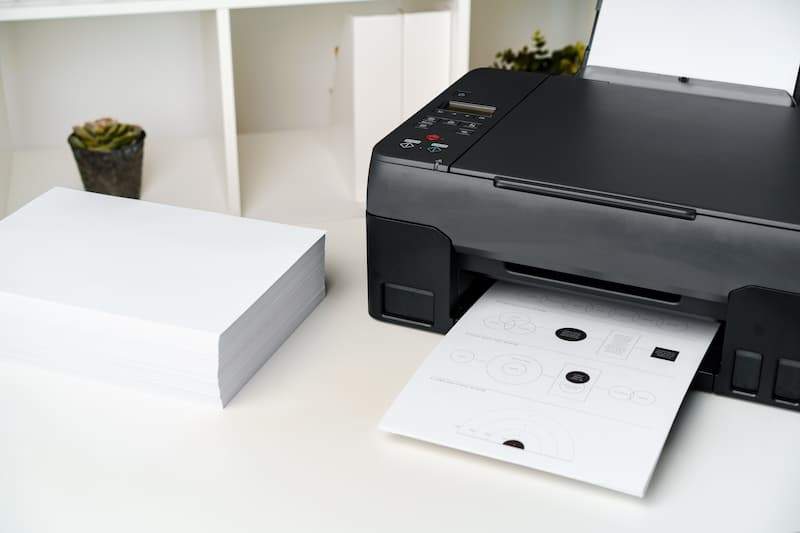
Standard Printer
Understanding the A-Series Paper Sizes (ISO 216 Standard)
The A-series paper sizes, governed by the ISO 216 standard, are the most widely used sizes globally, except in North America. The ISO A-series includes a range of paper sizes, starting from A0 (the largest) to A10 (the smallest). The most common size, A4, is used for standard printing in offices and homes worldwide. What sets the A-series apart is its logical aspect ratio of 1:√2, which ensures that each subsequent size is exactly half or double the size of the next, making it easy to scale documents up or down without distorting the content.
Popular A-Series Sizes and Their Uses:
- A0 (841 x 1189 mm): Used for large posters and technical drawings.
- A1 (594 x 841 mm): Ideal for flip charts and architectural plans.
- A2 (420 x 594 mm): Often seen in wall calendars and medium-sized posters.
- A3 (297 x 420 mm): Best for larger prints like diagrams and presentations.
- A4 (210 x 297 mm): The standard size for personal and office documents, such as letters and resumes.
- A5 (148 x 210 mm): Suitable for small booklets, flyers, and brochures.
- A6 (105 x 148 mm): Commonly used for postcards and small invitations.
A4 vs. Letter: What’s the Difference?
The minor difference between A4 and Letter size is a common challenge for people working with international documents. While A4 measures 210 x 297 mm (8.27 x 11.69 inches), Letter is slightly shorter and wider at 215.9 x 279.4 mm (8.5 x 11 inches). This discrepancy can cause issues during printing, such as misalignment, cut-off text, or extra space at the top or bottom of the page. It’s crucial to select the correct paper size based on your region and your audience’s location to avoid formatting issues.
Specialty Paper Sizes and Their Applications
While A4 and Letter sizes are the most common, other specialty paper sizes are used for specific applications. For example, Legal size is preferred for contracts and agreements in North America, offering more space for detailed clauses. Similarly, Tabloid size is often used for newsletters and bulletins, providing a larger canvas for visual content. Understanding these specialty sizes can help you select the right option for niche projects and ensure your documents look professional.
Choosing the Right Paper Size for Different Projects
The choice of paper size can significantly impact how a document is perceived. For general home or office use, A4 and Letter sizes are ideal. Marketing materials, on the other hand, often benefit from larger sizes like A3 or Tabloid, which allow for more impactful visuals. Legal documents should be printed on Legal size to accommodate lengthy text, while A5 and A6 sizes are great for compact brochures and postcards. When choosing a paper size, consider the type of content, intended use, and your printer’s capabilities to ensure optimal results.
Paper Weight and Thickness: Why It Matters
Beyond choosing the correct size, the weight and thickness of the paper (measured in GSM – grams per square meter) are crucial factors to consider. For standard document printing, 70-90 GSM paper is sufficient. For business or marketing materials, a thicker paper, such as 100-120 GSM, provides a more professional feel. High-end marketing materials, like premium brochures, often require paper with a thickness of 150 GSM or more. Selecting the right paper weight ensures durability, minimizes the risk of tearing, and makes your document feel more polished and professional.
FAQ: Understanding Printer Paper Sizes
What is the most commonly used paper size globally?
The most widely used paper size globally is A4, which measures 210 x 297 mm. As the international standard for paper sizes, A4 is the standard size defined by the ISO 216 series. It is commonly used for everyday office documents such as international letterhead size A4, forms, and standard business communication. In contrast, paper sizes in North America follow a different standard.
What is the difference between A4 and Letter size?
There is a size difference between A4 size paper and standard letter size commonly used in North America. A4, measuring 210 x 297 mm, is slightly taller and narrower compared to Letter paper, which measures 8.5 x 11 inches. This size in this system can cause issues when printing a4 documents on letter size, leading to formatting problems. It’s essential to select the correct paper size dimensions based on your region to avoid mismatched layouts and wasted sheets.
Can I use Legal size paper for standard printing?
Legal-sized paper (8.5 x 14 inches) is primarily used for contracts and legal documentation. While it is part of the paper sizes often used in offices, its longer length can create formatting challenges and paper jams if not set correctly. It is best to use standard letter size for everyday office printing unless the specific document requires legal-sized paper.
What are Tabloid and Ledger sizes used for?
Both Tabloid and Ledger sizes measure 11 x 17 inches, falling under larger paper sizes in the series of paper sizes. The difference is in their orientation: Tabloid is commonly used in portrait format for booklets and office printer newsletters, while Ledger, used in landscape orientation, is ideal for spreadsheets, charts, and graphic designs. Choosing the correct printing paper types depends on the nature of the document.
How does paper weight affect print quality?
Paper weight in the paper industry is measured in GSM (grams per square meter). It impacts the size of paper and its durability. Lighter paper used (70-90 GSM) is suitable for daily tasks and regular print jobs, while heavier paper (100-150 GSM) provides a more professional look and feel. Heavier paper is often used for larger paper sizes like A3 paper or high-quality marketing materials. Selecting the appropriate weight and size of paper enhances the final print quality, especially when using non-standard paper sizes.
By understanding these different paper sizes and their paper measurements, you can ensure that your print jobs meet both international standard for paper sizes and the standards for paper sizes defined in the world of paper—whether you are printing a4 and a5 sizes, paper sizes based on the ISO 216 series, or standard north American sizes such as Letter and Legal.



